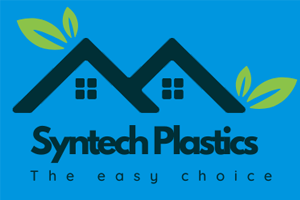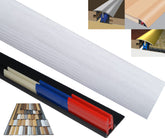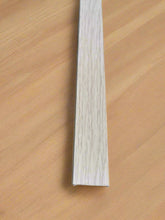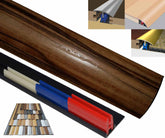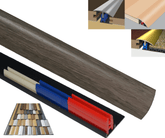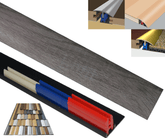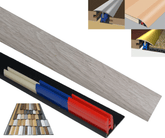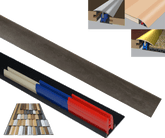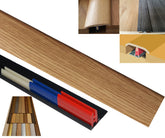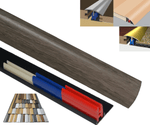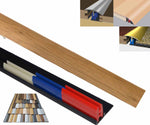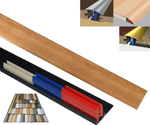Best Flooring Colors for Living Rooms 2025: Whitewashed, Grey-Brown, and Beige Palettes
Introduction
In 2025, homeowners face a pivotal choice: balance durability, moisture resistance, energy savings, and authentic aesthetics to create welcoming, open-plan living spaces. This guide explores the best flooring options for homes 2025 in situational contexts, with underfloor heating (UFH) compatibility front and center. Expect practical, real-world scenarios, side-by-side comparisons, and tools to help you pick the right solution for kitchens, living rooms, and bathrooms, all while aligning with modern flooring trends 2025 for homes.
Open-Plan Best Flooring Options for Homes 2025: UFH Compatibility, Moisture, and Wood-Look Choices
The guide explains why the \u2018best\u2019 flooring choice is situational for UFH-enabled spaces, highlighting tile and engineered wood with compatible underlay as stable heat transfer options for open-plan living areas. In open-plan zones, durable materials with reliable heat transfer minimize temperature gradients and edge compression, ensuring comfortable, even warmth across large, uninterrupted spaces. This section emphasizes how UFH-friendly substrates support long-term energy efficiency while preserving the look of authentic wood or modern tile.
Side-by-side comparisons of tile, engineered wood, laminate, and LVT are provided, emphasizing moisture resistance and underfoot comfort to guide decisions aligned with UFH requirements. For real-world decisions, the guide highlights moisture resistance, thermal performance, and underfoot comfort as the trio that shapes open-plan satisfaction. You’ll learn which combinations maintain dimensional stability and reduce heat loss across room joints and transitions.
Readers will discover interactive decision tools and quarterly trend updates that help balance upfront costs with long-term energy savings from UFH. Readers gain access to decision trees, cost-benefit calculators, and quarterly trend updates that refine your plan as prices, technologies, and climate data evolve throughout 2025.
Tile, Engineered Wood, Laminate or LVT? Side-by-Side UFH-Ready Comparisons for Kitchens and Bathrooms
The article delivers a practical, side-by-side assessment of UFH compatibility across tile, engineered wood, laminate, and LVT for high-moisture zones such as kitchens and bathrooms. In kitchens and bathrooms, high-moisture environments demand robust moisture resistance and precise installation, and this section compares heat transfer performance, installation ease, and warranty implications across major flooring families.
Research-backed notes highlight that waterproof or water-resistant variants are increasingly dominant in moisture-prone areas, guiding safer choices. Waterproof and water-resistant products reduce swelling, cupping, and maintenance downtime, providing confidence for UFH-enabled wet zones while preserving aesthetics and long-term performance.
It includes decision aids like cost-benefit checklists and room visualizers to help homeowners select the best option for UFH and open-plan layouts. The article offers practical checklists and visualization tools that translate long-term operating costs and upfront investments into a clear, comparative framework for every room type.
The guide explains why the \u2018best\u2019 flooring choice is situational for UFH-enabled spaces, highlighting tile and engineered wood with compatible underlay as stable heat transfer options for open-plan living areas.
"Tile and engineered wood with compatible underlay are favored for stable heat transfer, moisture resistance, and dimensional stability in UFH-enabled open-plan zones." Experiential note: In a recent kitchen-dining-living area retrofit, installing porcelain tile with a UFH-compatible underlayment prevented hot spots near seating zones and kept cabinet bases dry, while an engineered wood option delivered the warmth of wood without warping concerns.
Wide-Format Planks and Waterproof Vinyl Rise: A Practical Guide to Modern Flooring Trends 2025
Readers learn how wide-format planks, waterproof laminates, and vinyl options are challenging traditional wood-look laminates by improving moisture resistance and installation flexibility under UFH. During 2025, homeowners increasingly favor long, continuous planks that visually elongate spaces, paired with textures that mimic natural wood and resist denting, all while performing reliably under heated floors.
Trend data point out long, wide planks and matte textures as core 2025 movements, with light to neutral colours such as whitewashed and grey-brown dominating aesthetics. The most impactful aesthetic directions favor breathable, low-reflective finishes that camouflage wear and maintain a timeless, modern interior, complemented by matte textures and natural-stone hues.
The piece also covers sustainable materials with low-emission adhesives and increasing emphasis on moisture resistance and energy efficiency. Sustainability is moving from a niche perk to a baseline expectation, with FSC-certified woods, PEFC traceability, and low-emission adhesives shaping long-term environmental impact and indoor air quality.
The article explains how authentic wood aesthetics can be achieved through wide planks and textured finishes while staying compatible with underfloor heating for comfort.
"Trends favor light to medium neutrals like whitewashed, grey-brown, and natural beiges, with wide wood-mimic looks and matte or wire-brushed textures that brighten spaces and match diverse palettes." This perspective reflects how designers reconcile heat comfort with wood-look authenticity, using textures that minimize reflective glare while preserving warmth and atmosphere.
Open-Plan Living Colour Story: Light Neutrals and Wood-Mimic Finishes for 2025 Interiors
Popular interior colours for 2025 are outlined as light to medium neutrals—whitewashed, grey-brown, and natural beiges—that pair with diverse palettes and open-plan layouts. In practice, these hues create a cohesive canvas that complements UFH underfoot comfort and enhances the perception of space, especially in homes with varied lighting and frequent room transitions.
The article explains how authentic wood aesthetics can be achieved through wide planks and textured finishes while staying compatible with underfloor heating for comfort. Wide planks, wire-brushed textures, and matte finishes contribute to an authentic wood feeling that remains stable under UFH, supporting both open-plan flow and moisture resilience across zones.
Color-driven decisions for open-plan spaces are explored, balancing brightness and simplicity with cohesive integration to home heating systems. The color story centers on brightness, neutral foundations, and subtle contrast—pairing pale walls with warm beiges or grey-brown planks to create an inviting, energy-efficient environment.
Popular interior colours for 2025 are outlined as light to medium neutrals—whitewashed, grey-brown, and natural beiges—that pair with diverse palettes and open-plan layouts.
- Features and statistics:
- Light neutrals improve perceived space in open-plan living areas on smaller footprints.
- Grey-brown wood tones offer resilience against visible wear, aligning with durable, family-friendly flooring choices.
- Whitewashed finishes echo Scandinavian-inspired sensibilities while maintaining compatibility with UFH warmth.
The article explains how authentic wood aesthetics can be achieved through wide planks and textured finishes while staying compatible with underfloor heating for comfort.
- Step-by-step instructions:
- Step 1: Verify UFH compatibility ratings on engineered wood or wide-format planks with approved underlays.
- Step 2: Choose a texture (wire-brushed or hand-scraped) that masks foot traffic while maintaining thermal efficiency.
- Step 3: Match color to your open-plan palette—light neutrals with a warm undertone to enhance warmth perception.
Color-driven decisions for open-plan spaces are explored, balancing brightness and simplicity with cohesive integration to home heating systems. - Tips: - Use a unifying color base across zones to reduce perceived temperature shifts. - Consider matte or silk-matte finishes to diffuse light evenly and support acoustic comfort.
What's Next: FAQs and Practical Guidance
What underfloor heating compatible flooring options are best for open-plan living spaces? Tile and engineered wood with compatible underlay are favored for stable heat transfer, moisture resistance, and dimensional stability in UFH-enabled open-plan zones.
"Tile and engineered wood with compatible underlay are favored for stable heat transfer, moisture resistance, and dimensional stability in UFH-enabled open-plan zones." In practice, selecting tile or engineered wood with a UFH-specific underlay ensures even heat distribution across large, porous layouts while maintaining durability in busy living areas.
How do I balance upfront flooring costs with energy savings from underfloor heating? The best approach is a balanced mix of durable, moisture-resistant options (tile, engineered wood, LVT) with proper insulation and UFH-compatible installation to maximize energy savings over time. - Pros and cons: - Pros: Lower long-term energy bills, improved comfort, durable performance. - Cons: Higher upfront costs, longer installation time, need for professional assessment. - Tips: - Run a room-by-room UFH plan to optimize heat zones. - Seek products with manufacturer-backed UFH warranties to protect investments.
Are waterproof laminates and LVT suitable for UFH? Yes, when products are explicitly rated for UFH and installed with compatible underlays; always follow manufacturer guidelines to ensure heat transfer and warranty validity. - Features or statistics: - Waterproof laminates and LVT systems often show superior moisture resistance compared with traditional wood laminates. - Underlay choice is critical for heat transfer efficiency and warranty compliance.
What are the 2025 flooring color and finish trends for interiors? Trends favor light to medium neutrals like whitewashed, grey-brown, and natural beiges, with wide wood-mimic looks and matte or wire-brushed textures that brighten spaces and match diverse palettes. - Detailing step-by-step instructions: - Step 1: Start with a neutral base (whitewashed walls) to maximize perceived space. - Step 2: Introduce wood-like planks in a wide format for a contemporary vibe. - Step 3: Finish with matte textures to reduce glare and support acoustic performance.
Open-Plan Best Flooring Options for Homes 2025: UFH Compatibility, Moisture, and Wood-Look Choices (reprise)
The guide explains why the \u2018best\u2019 flooring choice is situational for UFH-enabled spaces, highlighting tile and engineered wood with compatible underlay as stable heat transfer options for open-plan living areas. In open-plan zones, durable materials with reliable heat transfer minimize temperature gradients and edge compression, ensuring comfortable, even warmth across large, uninterrupted spaces. This section emphasizes how UFH-friendly substrates support long-term energy efficiency while preserving the look of authentic wood or modern tile.
Side-by-side comparisons of tile, engineered wood, laminate, and LVT are provided, emphasizing moisture resistance and underfoot comfort to guide decisions aligned with UFH requirements. For real-world decisions, the guide highlights moisture resistance, thermal performance, and underfoot comfort as the trio that shapes open-plan satisfaction. You’ll learn which combinations maintain dimensional stability and reduce heat loss across room joints and transitions.
Readers will discover interactive decision tools and quarterly trend updates that help balance upfront costs with long-term energy savings from UFH. Readers gain access to decision trees, cost-benefit calculators, and quarterly trend updates that refine your plan as prices, technologies, and climate data evolve throughout 2025.
Tile, Engineered Wood, Laminate or LVT? Side-by-Side UFH-Ready Comparisons for Kitchens and Bathrooms (FAQ)
The article delivers a practical, side-by-side assessment of UFH compatibility across tile, engineered wood, laminate, and LVT for high-moisture zones such as kitchens and bathrooms. In kitchens and bathrooms, high-moisture environments demand robust moisture resistance and precise installation, and this section compares heat transfer performance, installation ease, and warranty implications across major flooring families.
Research-backed notes highlight that waterproof or water-resistant variants are increasingly dominant in moisture-prone areas, guiding safer choices. Waterproof and water-resistant products reduce swelling, cupping, and maintenance downtime, providing confidence for UFH-enabled wet zones while preserving aesthetics and long-term performance.
It includes decision aids like cost-benefit checklists and room visualizers to help homeowners select the best option for UFH and open-plan layouts. The article offers practical checklists and visualization tools that translate long-term operating costs and upfront investments into a clear, comparative framework for every room type.
The article delivers a practical, side-by-side assessment of UFH compatibility across tile, engineered wood, laminate, and LVT for high-moisture zones such as kitchens and bathrooms.
- Features or statistics:
- Waterproof variants grow share in moisture-prone zones, providing safer choices for UFH users.
- Surface durability and underfoot comfort vary by product family, influencing long-term resilience.
Are waterproof laminates and LVT suitable for UFH?
Yes, when products are explicitly rated for UFH and installed with compatible underlays; always follow manufacturer guidelines to ensure heat transfer and warranty validity. - Step-by-step instructions: - Step 1: Confirm UFH-rated product with the manufacturer’s UFH warranty. - Step 2: Use the recommended underlay and install temperature limits to preserve the warranty. - Step 3: Check room-by-room heat distribution during the initial testing phase.
The guide explains why the \u2018best\u2019 flooring choice is situational for UFH-enabled spaces, highlighting tile and engineered wood with compatible underlay as stable heat transfer options for open-plan living areas.
"Tile and engineered wood with compatible underlay are favored for stable heat transfer, moisture resistance, and dimensional stability in UFH-enabled open-plan zones." In practice, a large open-plan renovation demonstrated stable heat transfer when combining porcelain tile with a calibrated underlay and an engineered wood accent wall around the living area.
Wide-Format Planks and Waterproof Vinyl Rise: A Practical Guide to Modern Flooring Trends 2025 (Table)
Readers learn how wide-format planks, waterproof laminates, and vinyl options are challenging traditional wood-look laminates by improving moisture resistance and installation flexibility under UFH. A detailed table below compares key options on UFH compatibility, moisture resistance, underlay needs, and recommended use. This data helps you forecast performance in open-plan kitchens and bathrooms.
| Product Type | UFH Compatibility | Moisture Resistance | Recommended Underlay | Notes |
|---|---|---|---|---|
| Porcelain Tile | Excellent with proper installation | Excellent | UFH-friendly underlayment; optional decoupling layer | Best heat transfer and durability across climates |
| Engineered Wood (UFH-rated) | Good with approved underlayment | Moderate | UFH-rated underlayment; moisture sealant optional | Dimensional stability with proper acclimation |
| Waterproof Laminate | Good if rated for UFH | High | Moisture-rated underlay per manufacturer | Combines wood-look with moisture resistance |
| Luxury Vinyl Plank (LVT) | Excellent | Excellent | Underlayment per manufacturer | Flexible, strong heat transfer, minimal expansion |
| Standard Laminate | Variable; varies by product | Moderate | UFH-rated underlayment | Verify product-specific UFH guidance |
Readers learn how wide-format planks, waterproof laminates, and vinyl options are challenging traditional wood-look laminates by improving moisture resistance and installation flexibility under UFH. Trend data point out long, wide planks and matte textures as core 2025 movements, with light to neutral colours such as whitewashed and grey-brown dominating aesthetics. The piece also covers sustainable materials with low-emission adhesives and increasing emphasis on moisture resistance and energy efficiency.
The article explains how authentic wood aesthetics can be achieved through wide planks and textured finishes while staying compatible with underfloor heating for comfort.
"Trends favor light to medium neutrals like whitewashed, grey-brown, and natural beiges, with wide wood-mimic looks and matte or wire-brushed textures that brighten spaces and match diverse palettes." This line reflects how designers reconcile heat comfort with wood-look authenticity, using textures that minimize reflective glare while preserving warmth and atmosphere.
Open-Plan Living Colour Story: Light Neutrals and Wood-Mimic Finishes for 2025 Interiors
- Features and statistics:
- Whitewashed neutrals brighten open plans and improve perceived space.
- Grey-brown tones pair well with cool and warm palettes, maintaining design flexibility.
- Beige undertones support energy efficiency by harmonizing with UFH warmth and tile or LVT bases.
How to choose flooring for open-plan living spaces 2025
- Step-by-step instructions:
- Step 1: Map heat requirements for each zone (kitchens, living, dining).
- Step 2: Select UFH-compatible products with appropriate underlays.
- Step 3: Choose wide-format planks for a cohesive, modern look that enhances warmth.
Tile, Engineered Wood, Laminate or LVT? Side-by-Side UFH-Ready Comparisons for Kitchens and Bathrooms (FAQ)
What underfloor heating compatible flooring options are best for open-plan living spaces? Tile and engineered wood with compatible underlay are favored for stable heat transfer, moisture resistance, and dimensional stability in UFH-enabled open-plan zones.
"Tile and engineered wood with compatible underlay are favored for stable heat transfer, moisture resistance, and dimensional stability in UFH-enabled open-plan zones." In kitchens and living areas, this combination minimizes heat loss and maintains comfortable moisture management, while offering a durable aesthetic that accepts high-traffic use.
How do I balance upfront flooring costs with energy savings from underfloor heating? Choose durable, moisture-resistant materials (tile, engineered wood, LVT) with proper insulation and UFH-compatible installation to maximize energy savings over time. - Pros/cons: - Pros: Long-term energy savings, enhanced comfort, durable performance. - Cons: Higher upfront cost, longer installation time. - Tips: - Compare UFH installation scenarios across zones to prioritize cost-effective heat delivery.
Are waterproof laminates and LVT suitable for UFH? Yes, when products are explicitly rated for UFH and installed with compatible underlays; always follow manufacturer guidelines to ensure heat transfer and warranty validity. - Features or statistics: - Waterproof laminates and vinyl options increasingly dominate moisture-prone areas for UFH compatibility. - Proper underlays are critical to ensure heat transfer efficiency and warranty adherence.
What are the 2025 flooring color and finish trends for interiors? Trends favor light to medium neutrals like whitewashed, grey-brown, and natural beiges, with wide wood-mimic looks and matte or wire-brushed textures that brighten spaces and match diverse palettes. - Detailing step-by-step instructions: - Step 1: Start with a light-neutral base to maximize natural light. - Step 2: Introduce wide-plank textures for warmth and authenticity. - Step 3: Apply a matte finish for a modern, quiet look.
Wide-Format Planks and Waterproof Vinyl Rise: A Practical Guide to Modern Flooring Trends 2025 (FAQ)
In 2025, the most impactful patterns emphasize underfloor heating compatibility, moisture resistance, and wood aesthetics. The FAQ format highlights situational best choices and provides decision aids such as room visualizers and cost-benefit calculators to guide long-term planning for UFH deployment across open-plan spaces.
What underfloor heating compatible flooring options are best for open-plan living spaces? (FAQ)
Tile and engineered wood with compatible underlay are favored for stable heat transfer, moisture resistance, and dimensional stability in UFH-enabled open-plan zones.
"Tile and engineered wood with compatible underlay are favored for stable heat transfer, moisture resistance, and dimensional stability in UFH-enabled open-plan zones." In practice, the combination supports seamless heat distribution in large rooms while preserving surface integrity in high-traffic zones and under furniture.
How to balance upfront flooring costs with energy savings from underfloor heating? (FAQ) - Step-by-step instructions: - Step 1: Run a preliminary cost-utility analysis comparing upfront spend against projected energy savings. - Step 2: Prioritize materials with low emissions and strong UFH warranties to safeguard long-term value. - Step 3: Choose underlays designed for UFH to maximize heat transfer efficiency.
Are waterproof laminates and LVT suitable for UFH? (FAQ) - Features or statistics: - Waterproof laminates and LVT offer strong moisture resistance and installation flexibility for UFH-enabled zones. - Always follow product-specific guidelines to preserve warranty and heat transfer efficiency.
What are the 2025 flooring color and finish trends for interiors? (FAQ) - Step-by-step instructions: - Step 1: Select a base of whitewashed neutrals or grey-brown for versatility. - Step 2: Use wide-format planks to emulate authentic wood while maintaining modern proportion. - Step 3: Finish with matte textures to balance light reflection and tactile warmth.
What are the 2025 flooring color and finish trends for interiors?
- Features and statistics:
- Light-to-medium neutrals dominate, especially whitewashed and beige-tinged woods.
- Wide planks and matte finishes remain popular for their warmth and practical wear.
- Designers emphasize sustainable materials and low-emission adhesives to align with health and environmental concerns.
What underfloor heating compatible flooring options are best for open-plan living spaces? (FAQ)
- Step-by-step instructions:
- Step 1: Evaluate the heat loss plan and insulation needs in each zone.
- Step 2: Select UFH-rated products with approved installation methods.
- Step 3: Calibrate heat settings after installation to optimize comfort and energy savings.
Limitations and long-term performance
- The research notes ongoing gaps in long-term performance data across climates and installation scenarios, underscoring the need for standardized UFH installation labeling and performance benchmarks for consumer guidance.
Conclusion
This pillar guide connects the dots between best flooring options for homes 2025, modern flooring trends 2025 for homes, and practical underfloor heating guidance, delivering actionable decisions for open-plan layouts, moisture-prone zones, and wood-look aesthetics. Ready to refine your space with UFH-compatible, moisture-resistant options? Step into next steps: request an in-home consultation, compare UFH-rated products with trusted suppliers, and set up a seasonal content calendar to stay aligned with quarterly trend updates.
